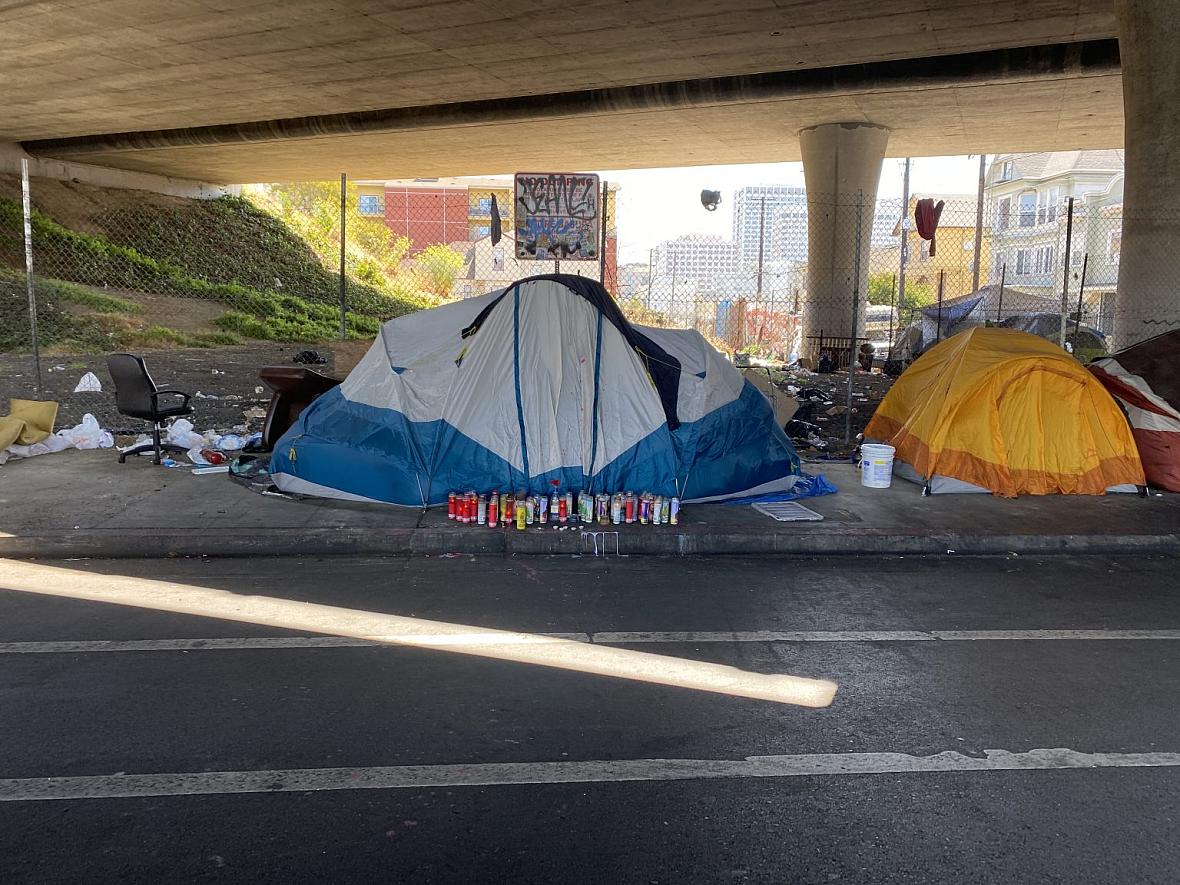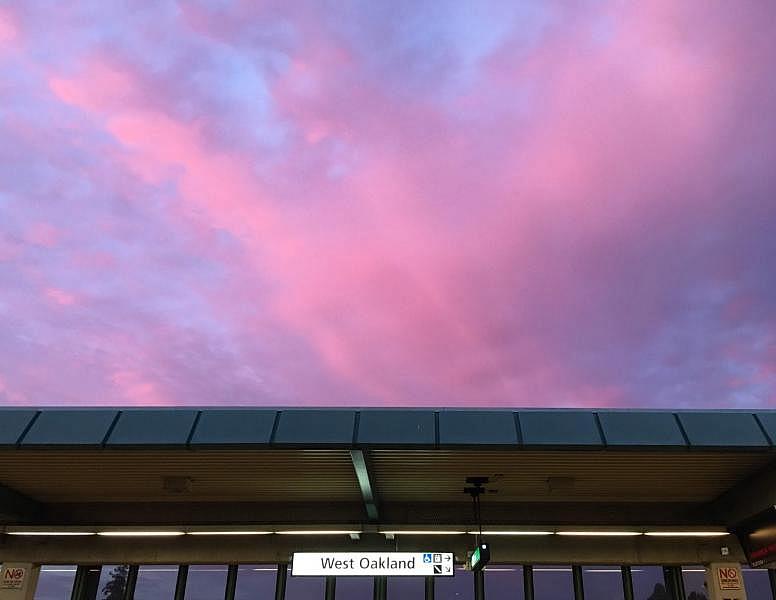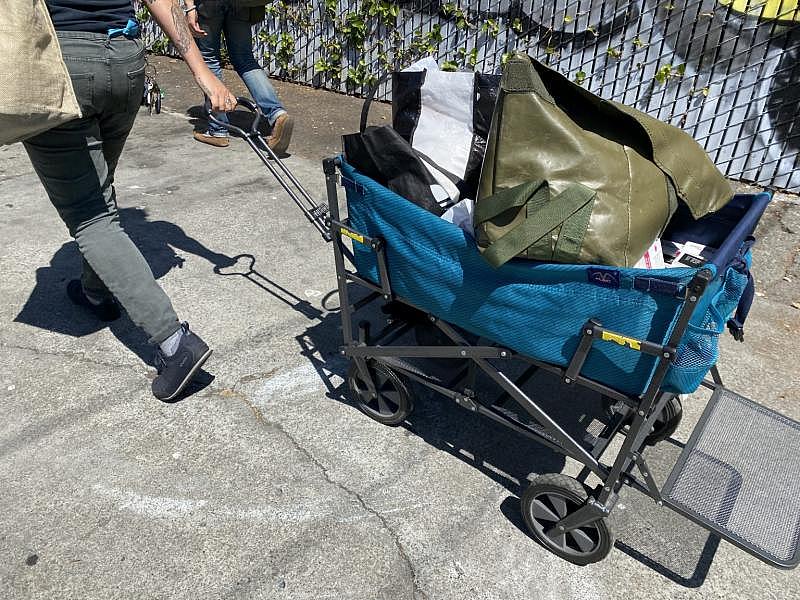Alameda County doesn't track deaths of unhoused people — here's why that impacts the opioid crisis
This article is part two of a reporting series by Ariel Boone for Street Spirit and KPFA Radio with a USC Annenberg Center for Health Journalism 2021 California Fellowship.
Her others stories include:
Part 1: Opioid Overdoses Are At Record Highs. It Doesn't Have To Be This Way.
Special report on opioid crisis in Oakland’s unhoused community: Voices of overdose and survival

Candles create a vigil outside the tent of an unhoused community member who was shot in West Oakland—one example of many in which unsheltered people grieve the loss of friends and family members on the street.
(Ariel Boone)
One night in early July, Jeremiah was riding BART home to West Oakland. It was the last train of the night toward San Francisco, and he had his bicycle, so he chose the last car. A group of people boarded the train at MacArthur Station in Oakland.
“They all sit in the back and they smoke, especially when they’re going to the city,” Jeremiah explains.
Sunset at the West Oakland BART station. (Ariel Boone)
After Jeremiah administered the first dose of Narcan, he started jostling the stranger to wake her up. Somewhere between the 19th Street and 12th Street BART stations in Oakland, the woman regained consciousness. He gave her a second dose, and then Jeremiah had to go.
Best practices suggest continuing to observe a person for an hour after reviving them, because they could require additional doses of Narcan. But he had to get off of the train at West Oakland, since there would be no easy way to get back from San Francisco after BART closed with its limited pandemic hours.
According to data Street Spirit obtained in a public records request, BART police report administering Narcan 79 times on station platforms and trains since the agency began keeping records in August 2019.
BART ridership plummeted during the pandemic, as housed residents who were able to shelter and work at home avoided public transit. But during California’s coronavirus surge in the winter of 2020, BART recorded two of its worst months for overdoses, administering Narcan to 15 people from December 2020 through January 2021.
This wasn’t the first time Jeremiah administered Narcan and reversed an overdose: He says in the past, he revived his neighbor, a stranger in El Cerrito, and two people in Downtown Oakland. But none of these overdose reversals will show up in public numbers. Paramedics weren’t called, police weren’t deployed. And that’s because members of the unhoused community and people who use drugs are reversing hundreds of overdoses each year in Alameda County themselves, without involving public services or officials.
This makes the true scale of the overdose crisis somewhat invisible: Government recordkeeping currently does not reflect the extent to which people who use drugs are keeping each other alive. Without this information, how can public health programs best support the unhoused people who are battling overdose?
THE UNCOUNTED — FATAL OVERDOSES ON THE STREET
Since the arrival of the coronavirus pandemic, opioid overdose has claimed the lives of over 170 people in Alameda County, with a 40 percent increase in fatalities from 2019 to 2020, driven by fentanyl, an unreliable drug supply, and the increased trauma and instability of life during COVID.
Alameda County submits data to the California Department of Public Health about fatal opioid overdoses and emergency department visits, with detailed information about which drugs were involved. But the county does not tally the housing status of those who die from overdose. Multiple coroner’s bureau staff confirmed to Street Spirit that their records do not consistently note whether someone was unhoused when they died. Their records mark some unhoused people, but not all, as “transient”—an outdated and imprecise label, advocates say.
In fact, when it comes to death records, Alameda County doesn’t track housing status at all.
“Homeless mortality reporting has never been something that has been carried out in our county on a county-wide basis,” confirms David Modersbach, from Alameda County Healthcare for the Homeless.
Without this data, it’s impossible to know how unhoused people are dying, or where—or which interventions seem to be working.
“That story of their housing status really tells us a good bit about the experience around their death,” Modersbach explains. With stronger epidemiological data about unhoused people’s deaths, he says, “you can find out who died. You can actually track what was going on with that person, and what kind of care were they getting—or not? Throughout the system, who was touching those people, what were the incidents that led to their deaths, and how could that have been improved, and how could that death have been prevented?”
Modersbach works to understand this picture by cobbling together whatever mortality information he can find. He combs names from end-of-year memorials for unhoused people held by advocates and service providers, such as the annual homeless memorial at Oakland’s St. Mary’s Center. He examines death forms submitted by skilled nursing facilities and pores over coroner’s records. He developed an online form that allows community members to submit the names of unhoused friends and family who have died, and does outreach to solicit submissions. Modersbach compares each of these records with data about people who have accessed county services.
I’m just determined to breathe for them. If I have to breathe forever.
He and four colleagues are currently assembling a three-year report from 2018 to 2020, examining the records of all approximately 32,000 people who died in Alameda County during that time, and attempting to triangulate whether each person who died was homeless: an enormous task. He calls it a “labor of love”—the county has not assigned any single staff person to head this project, and it’s work Modersbach and his colleagues do on top of their other responsibilities. Once this record compilation is complete, Modersbach hopes to assemble a community task force to decide what information should be gleaned from the data, and to produce yearly reports moving forward.
“It’s so critical to have that information,” says Modersbach. “We feel like it’s absolutely required, but it’s understaffed.”
County employees told me that this process could be much simpler if the state required housing status to be reported with death records—and if the county devoted more resources and staff time to the project.
Modersbach and his colleagues have not yet concluded their preliminary analysis, but his first glimpse at the data they have collected made it clear that the role of overdose in homeless deaths is “huge.”
Without this information about overdose in the unhoused community—and when or whether it leads to death—the government lacks a complete view of the crisis and how it intertwines with houselessness as opioid overdoses climb to record highs in Alameda County and nationwide.
But not all opioid overdoses end in death—most in Alameda County are reversed with Narcan. To assess the full scale of the opioid crisis, advocates say, we must also look at how many overdoses are being reversed on the street.
INVISIBLE OVERDOSE REVERSALS: WHEN 911 ISN’T CALLED
The nasal spray form of Narcan, from the Punks With Lunch outreach wagon. (Ariel Boone)
In the first story in this series, we spoke with Thad, a 36-year-old resident of North Oakland. Thad has survived three overdoses since the pandemic began, all after smoking fentanyl.
Since his first overdose in 2020, Thad estimates he’s been present for at least 10 overdoses where he administered Narcan, or helped. It’s fairly common to witness overdoses when you’re around drugs, he says.
“Before that, I hadn’t administered Narcan, but I’d had to breathe for someone for a long time and give them mouth-to-mouth,” he remembers. “And luckily—thank god—I’ve not lost anybody. Because I’m just determined to breathe for them, if I have to breathe forever.”
Thad knows fentanyl is potent and feels a strong responsibility to the people who use drugs around him. He carries Narcan in a red zipper pouch that always hangs around his neck, under his shirt. And he avoids smoking fentanyl with first-time users, because of the high overdose risk to them, he says.
Alameda County urges anyone who witnesses an overdose to call 911. But people using drugs told Street Spirit that they may only call 911 for assistance during an overdose if they don’t have enough Narcan on hand, or if someone is very ill.
“The community has become so intimately acquainted with reviving others themselves, and that is such a regular occurrence, that I don’t think people bother with 911 a lot,” explains Katie O’Bryant, of the harm reduction group West Oakland Punks With Lunch. O’Bryant was houseless for over 10 years and describes herself as a longtime drug user. She also notes that community members do not trust law enforcement, which sometimes responds to 911 calls.
While harm reduction advocates employ empathy and acceptance in their work, many people who use drugs say police represent the opposite. Police departments nationwide are facing a reckoning over brutality and racism. In Oakland, they also enforce the city’s drug laws and appear at sweeps where public agencies destroy tents and belongings.
If bystanders encounter someone who might be overdosing, advocates recommend not mentioning “drugs” or “overdose” on the phone when calling 911, to avoid drawing police to the scene.
Alameda County Healthcare for the Homeless senior pharmacist Seth Gomez agrees. “Experiencing overdose, that in itself is very traumatic for somebody,” Gomez says. “Anything we can do to limit that further I think is a good decision. And I think that limiting law enforcement [at] a scene is probably one of the better things that we can do when responding.”
The National Harm Reduction Coalition says there is a risk that police who respond to overdose in some jurisdictions may arrest bystanders, or charge people at the scene of an overdose with drug possession or manslaughter.
Also concerning is the approach of some emergency medical services workers. Two people who deal with addiction and spoke with Street Spirit said they have lost trust in emergency medical service personnel. Online EMS meme accounts like “worstresponders” and “Burned Out Memes for EMS Teams,” followed by emergency responders across the world, post images joking about overdose deaths, calling people who use drugs “junkies,” expressing annoyance at providing services, and in some cases, making morbid jokes about people who overdose. One of the memes Street Spirit found depicted a smiling anime character with the caption, “When you look down at the bum who calls you every shift and notice that he isn’t breathing.”
This toxic online culture reflects an attitude of burnout and disrespect that unhoused people say can translate in person.
“I don’t really forgive it, the way that they handle it,” says Thad, who says he has witnessed dismissive behavior by emergency medical responders toward people who use drugs in Oakland.
One time, Thad says, responders lectured someone after responding to a 911 call for an overdose, because they had been called multiple times in the past to assist the same person. EMS workers have a name for people who have emergency services called on them often—a “frequent flyer.” And these individuals can be subject to harsh treatment.
“The police, I kind of expected it from, because of the way that they’re trained and their history. But to see it with paramedics was kind of shocking,” Thad says—”to see someone just seemingly not really care, or just how rough they handle someone who’s in such a fragile state of existence.”
Street Spirit reached out to Alameda County Emergency Medical Services for comment. The county said they are not able to speak to the behavior of individual providers, but encouraged the public to submit complaints if they encounter issues when calling 911.
County spokesperson Neetu Balram also said the county is currently in the process of updating its EMS protocols to include linking more people with opioid use treatment services and offering supplemental training for providers on empathetic care.
“We urge everyone experiencing an overdose or friends and family of those experiencing one to call 911,” Balram said.
For now, data about emergency calls for opioid overdose give an incomplete picture of how many overdose reversals are happening in the county. When unhoused people successfully reverse overdoses on their own, that incident goes uncounted by the government.
Meanwhile, affected community members continue to reverse overdoses for each other. To do this, they must carry Narcan themselves.
UNHOUSED PEOPLE AS FIRST RESPONDERS
The Punks With Lunch outreach wagon, rolling along a West Oakland sidewalk. (Ariel Boone)
On a Tuesday morning in August 2021, Punks With Lunch outreach worker Katie O’Bryant calls out to residents of Martin Luther King Jr. Way and 23rd Street, who have made homes underneath a noisy freeway overpass.
“Good morning folks—needle exchange! Pipes, hygiene, food. We’ve got hot burritos!”
Punks With Lunch is a spunky volunteer organization founded in 2015 to distribute life-preserving supplies to people who use drugs in West Oakland. The group’s founder, Ale Del Pinal, told Street Spirit that they have handed out some-8,000 doses of Narcan.
Every time they give out Narcan, the Punks ask participants if they’ve had to reverse an overdose in the last week. Outreach coordinator Katie O’Bryant says they always hear at least three yeses.
During the pandemic, verbal reports of overdose reversals have also increased. “It’s been pretty drastic,” confirms Ale Del Pinal. “As a really small organization, we saw 670 overdose reversals [in 2020], compared to the 400-and-something from the year before.” This does not include the number of overdoses that have been reversed by the participants of the other harm reduction groups in Alameda County.
Compare this to the county’s totals: EMS workers in Alameda County responded to 716 overdoses in the whole of Oakland in 2020—not just in West Oakland, where Punks with Lunch operates.
This data paints a picture: unhoused people and people who use drugs are the primary first responders to overdoses on the street.
The Punks roll supply carts along the length of both cross streets. People emerge from tents, cars, and self-built shelters to pick up supplies and connect with Del Pinal, O’Bryant, and the volunteers.
It feels exposed and treacherous underneath the freeway. The day before, one of the Punks With Lunch participants living here was murdered. There are prayer candles outside the tent where they used to live. A woman walks down the street waiting for medical care because she was bitten by her dog. Meanwhile, a man parks a large white van next to the tents and starts yelling through a megaphone at the unhoused residents to repent and turn to Jesus. It’s chaotic and loud. This is the experience of homelessness, even before the pandemic, as unhoused people are relegated to the least comfortable places to live, and exposed to the trauma of the street.
“MORE THAN ANYTHING, I GRIEVE”
Barry Biddulph and Charlie Brown. (From Biddulph’s Facebook page)
In June 2021, two men, 41-year-old Barry Biddulph and 52-year-old Eric Cumby, were found dead in Civic Center Park, in the heart of Downtown Berkeley.
Ana is an unhoused mother from Mexico who has lived near the park for years.
The morning of the overdose, Ana spent time with Eric Cumby. They chatted in the park, and he left to run an errand. A couple hours later, she saw police turning his body over. Then, Ana heard a voice call out in the park that another body was found: Barry Biddulph.
Biddulph was a friend to Ana. On Facebook, there’s a photo of Biddulph smiling and holding his fist against a Charlie Brown statue, like he’s giving the statue a knuckle sandwich.
A few hours after residents watched police remove their bodies, Ana had to go to her job at a department store.
“I was riding my bike to work that afternoon and I was shaking,” she says. “It’s traumatizing and we had no help. Nobody addressing us, nobody talking to us, not one human being.”
Ana says residents heard there was a bad batch of drugs around, but she’s not certain. Toxicology reports take months, and it’s not guaranteed that anyone from the county or city will return to the park to tell residents the results and give them closure.
Across the bay, San Francisco is tackling this lack of follow-up by devoting more funding for street outreach and overdose prevention. In August, San Francisco launched Street Overdose Response Teams, a program to target individuals after they survive an overdose, and prevent future overdoses.
The San Francisco Department of Public Health intends to maintain a registry of people at “high risk” of overdose, and deploy firefighter paramedics and public health workers to meet with survivors within 72 hours of an overdose to connect them with services and treatment. Hospitals, 911 responders, and community groups are supposed to identify people who have just survived overdose, and report them to the program. It’s part of a $13.2 million effort to prevent overdoses in San Francisco. No such government-led efforts are currently underway in Alameda County.
After the overdoses in Civic Center Park, Berkeley NEED, another local harm reduction organization, came out to the park in the days after the overdoses and handed out Narcan and fentanyl test strips—Ana now carries them in her purse.
“We within the homeless community, we do look after each other. That’s how I’m still standing,” says Ana. “We share with each other: When I don’t have smokes, somebody does. When I got money, I share, you know? It’s that kind of beautiful relationship that is humanity. And we do it out of necessity.”
Ana and her neighbors are equipping themselves and each other with supplies to save lives from opioid overdose. They are also the ones who most frequently witness these deaths, and among the few who take time to mourn the lives that are lost on the street.
Though official statistics do not accurately count unhoused people who die from overdose in Alameda County, these lives are remembered by people like Ana, and groups like West Oakland Punks With Lunch.
Punks With Lunch is currently building an altar in their space for community members they have lost. Someone has carefully hand-stenciled lettering on the wall, and an armful of prayer candles sits on a wooden ledge below. One of the candles has a blue and white design, an outline of what looks like a dragon, going after a police officer. It says “Contra La Ley—Law Stay Away.”
Standing in the Punks With Lunch office, Katie O’Bryant points to the wall and describes plans for a mural of poppies and coca plants: Plant medicines, she explains, in honor of the people who have died while dealing with homelessness and addiction.
“We see a lot of death,” Ale Del Pinal tells Street Spirit. “I was talking to somebody about grief and the person said, ‘The grief that you feel is a sign of how much you loved that person or love that community.’
“I grieve a lot.” Del Pinal said, and paused. “More than anything, I grieve.”
This article is part two of a reporting series for Street Spirit and KPFA Radio with a USC Annenberg Center for Health Journalism 2021 California Fellowship. Ariel Boone is a freelance journalist and reporter for KPFA Radio in Oakland, California. Ariel previously worked at Democracy Now! in New York.
[This article was originally published by the Street Spirit.]
